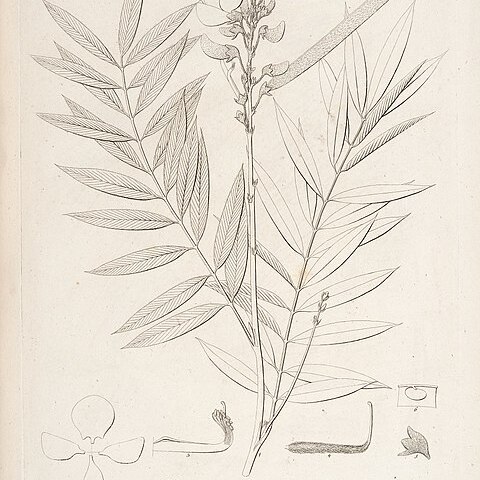Herbs, perennial, suffrutescent, 1-3.5 m tall. Stems ridged, grayish white tomentose, trichomes ca. 1 mm. Leaves 17-25-foliolate; rachis 15-25 cm, including petiole 1-3; leaflet blades oblong, 3-6 × 0.6-1.4 cm, abaxially densely sericeous, adaxially glabrous, secondary veins 30-50 on each side of midvein. Pseudoracemes terminal or lateral, 15-20 cm. Pedicel ca. 1 cm, densely white villous. Flowers ca. 2 cm. Calyx ca. 5 × 5 mm; teeth equal, ca. 1 mm, apex rounded. Corolla white, rarely yellow or pale pink; standard densely sericeous. Ovary tomentose, with numerous ovules. Legume linear, 8-10 cm × 7.5-8.5 mm, straight, brown tomentose with a mixture of long and short trichomes, apex truncate and with a straight ca. 1 cm beak. Seeds 10-15 per legume, olive-green with dark patches, ellipsoid, ca. 5 × 3.5 mm, smooth. Fl. Oct-Nov, fr. Dec. 2n = 22, 24.
More
A shrub. It grows 3.5 m tall. The branches are straggly from the base. The leaves are arranged in spirals. They have leaflets along the stalk and one at the end. The flowering shoots are at the ends of branches. The fruit are narrow pods with 10-15 seeds. These are about 4 mm long.
Primary and secondary forest, higher locations in sago-palm swamps and disturbed places such as roadsides, riverbanks, steep slopes and fields.
More
It is a subtropical plant. It grows in secondary forests and along roadsides and riverbanks.

